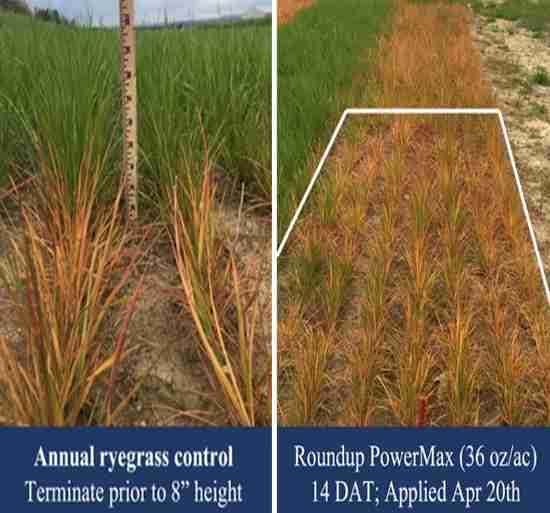By John Wallace and Dwight Lingenfelter
Selecting the right herbicide burndown program for cover crop termination will be necessary to start clean this growing season. Key considerations include the cover crop species or mixture, cover crop growth stages, weeds present that require control, and weather conditions near the time of burndown applications.
In previous articles, we have addressed reduced- or non-glyphosate burndown strategies given short supplies and significant costs this growing season. However, we strongly recommend use of glyphosate at full rates for controlling annual ryegrass (Lolium multiflorum) stands this spring.
Annual ryegrass termination. Careful consideration of herbicide management for annual ryegrass is needed, particularly given concerns about its potential to become an established and persistent volunteer weed problem. Glyphosate has significantly better activity on annual ryegrass than paraquat (Gramoxone) and should be used as the base product. In order to optimize glyphosate applications for annual ryegrass control:
- Time applications to sunny, warm days (>55°F) and actively growing plants
- Consider terminating prior to rapid growth stages (<8-inch) for improved control
- Use high glyphosate rates (1.25 to 1.5 lb ae/ac) with appropriate adjuvants
- Avoid use of 28 or 32% UAN and high-rates (>0.25 lb ai) of clay-based herbicides (WDG, WG, DF, DG, F) like atrazine, simazine and metribuzin to reduce tank-mix antagonism
Penn State field trials conducted in 2020 demonstrate the utility of tank-mix partners to improve annual ryegrass control under challenging weather conditions. Roundup PowerMax (36 fl oz/ac; 1.25 lb ae) applied on April 20th to 6-8" annual ryegrass during a week of cooler weather conditions (~50°F day-time temperatures) provided only partial control, which resulted in ryegrass regrowing and going to seed. In comparison, tank mixing glyphosate with Select Max (8 oz/ac + MSO; clethodim) or Resolve (1 oz/ac; rimsulfuron) resulted in >95% control 2 months after treatment.
Consult herbicide labels if considering tank-mixing glyphosate with clethodim- or rimsulfuron-containing products. Select Max (clethodim) can be applied at a 6 fl oz/ac rate and Clethodim 2EC can be applied at a 3 fl oz/ac up to 6 days prior to corn planting and have no soybean planting restrictions. Resolve (rimsulfuron) at a 1 oz rate or Basis Blend (rimsulfuron + thifensulfuron) at a 1.5 oz rate should provide adequate weed control, increase cereal rye termination efficacy, and reduce the potential for corn injury. Application of rimsulfuron can result in corn injury under cool, wet conditions and under coarse soils. Rimsulfuron products are not labeled for soybean production.
Herbicide recommendations for termination of various cover crop species prior to corn ( Table 2.2-4 ) and soybean ( Table 2.4-4 ) can be found in the Penn State Agronomy Guide.

Left: Annual ryegrass terminated with an herbicide when less than eight inches in height.
Right: Annual ryegrass fourteen days after application of Roundup Powermax (36 oz per acre).
Source : psu.edu